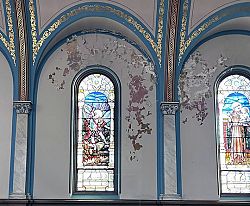Holy Cross Hospital works to reclaim its historic chapel
Friday, Oct. 31, 2025

IC photo/Marie Mischel
+ Enlarge
The chapel at Holy Cross Hospital in Salt Lake City, which was dedicated in 1904, has suffered from neglect, and also was damaged by the 2020 earthquake. A capital campaign has started to raise funds to restore the chapel, which still boasts its original windows and pews.
SALT LAKE CITY — CommonSpirit/Holy Cross Health Foundation has launched a capital campaign to raise funds for the restoration of the historic chapel on the campus of Holy Cross Hospital in Salt Lake City. This multi-phase restoration project is a $10.5 million initiative aimed at bringing the historic structure back to life as a community resource and spiritual anchor for the recently re-established Catholic hospital.
The chapel was established as part of Holy Cross Hospital, which was founded in 1875 by the Sisters of the Holy Cross. The chapel was built between 1901 and 1904 and dedicated on April 14, 1904. It was designed by Carl M. Neuhausen, the same architect responsible for the Cathedral of the Madeleine, and the two buildings share a similar architectural style.
The chapel was named to the State Historic Registry in 1976 and for many years served as a nondenominational interfaith sanctuary at the hospital. It was closed in 1995 when the Sisters of the Holy Cross sold the hospital, which was later renamed Salt Lake Regional Medical Center.
Over time, the 120-year-old structure has suffered from neglect, and it was significantly damaged in the 2020 earthquake. Cracks in the walls and peeling paint are some of the most obvious signs of the need for restoration.
In 2023, CommonSpirit Health acquired the hospital and renamed it Holy Cross Hospital Salt Lake, reestablishing it as a Catholic healthcare facility. Officials have committed to restoring the chapel and “bring it back to the community as a sacred space for healing and prayer,” said Kyle Braithwaite, the organization’s chief philanthropy officer. “In 2023, when CommonSpirit purchased the five hospitals here in Utah, there was a commitment as the largest Catholic-based health organization in the country to really honor the heritage that the Sisters of Holy Cross brought to Utah.”
Braithwaite described the effort as a “faith-based commitment to bringing the healing presence of God to all people, to building a hospital system that promotes community involvement.”
Ultimately, the restoration is about “revitalizing and restoring this beautiful religious artifice,” he said.
CommonSpirit Health has committed $4 million toward the restoration project as a matching grant, which will serve as seed money.
“Our goal is to raise to just over $10 million in order to bring it to its full usability, utility and community appreciated state,” Braithwaite said.
Restoration Efforts
The restoration, which officials hope will begin next spring and take about 18 months, will focus on preservation, modernization and expansion of the building, following a three-tiered approach of “must do,” “should do” and “nice to have” improvements based on fundraising progress.
The restoration will address structural damage, including masonry and roof repairs, with seismic improvements and earthquake-proofing, such as reinforcing first-floor masonry walls. The 11 painted glass windows and fresco paintings will be restored. Interior features like pews and altars will be replaced or repaired, and the original brick will be revealed by removing paint from the exterior façade.
In addition, there will be updates to key infrastructure such as plumbing, electrical and technology systems. A new water heater is expected to be installed, along with accessibility and safety features.
The finished space is intended to create a new usable community space open to Salt Lake City residents as well as to employees, patients and their families. The foundation’s vision is “to restore it in its highest degree back to a very community-centric space where the community can utilize it,” and a “sacred space and a spiritual refuge for people of all faiths, or non-faiths to be able to come as they personally or their loved ones are going through treatments here at the Salt Lake campus to be able to find refuge,” Braithwaite said.
For questions, comments or to report inaccuracies on the website, please CLICK HERE.
© Copyright 2025 The Diocese of Salt Lake City. All rights reserved.
© Copyright 2025 The Diocese of Salt Lake City. All rights reserved.

Stay Connected With Us